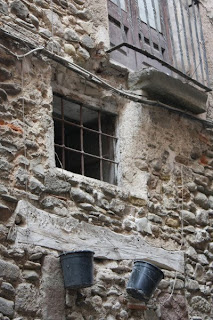As we walked into the city from the railroad station, we entered the Plaça Mayor, a huge open space surrounded by buildings of varying ages, many of them arcaded.
 The 16th century Ayuntamiento - town hall - sits in one corner of the square with its tower, crest and Catalan flag.
The 16th century Ayuntamiento - town hall - sits in one corner of the square with its tower, crest and Catalan flag.

From there we set off wandering through the narrow, meandering streets of the old city, past old buildings.
One building dating from the 15th and 16th centuries had Moderniste period details, such as this iron grating, added in the 19th century.

 One side of this 17th century convent cloister houses an art school.
One side of this 17th century convent cloister houses an art school. Which explained the self-referential decor of this serveis (toilet).
Which explained the self-referential decor of this serveis (toilet).More conventional sights included this hospital facade
 from the 16th century.
from the 16th century. And a Roman bridge.
And a Roman bridge.The cathedral in the center of old Vic has a long history, but the current building dates only from the late 18th century. Its interior is covered with murals painted by the Catalan Jose Maria Sert, not once but twice. He painted murals in 1930, but the church was burned in 1936 at the beginning of the Spanish Civil War. Sert repainted the murals beginning in 1945. They are mostly in shades of grey, so that the figures resemble marble statues. Furthermore, most of the interior not covered by murals, for example all of the columns, are painted to resemble dark wood. The overall effect is very dark.
 But a small chapel off the cathedral cloister had nicely diffused lighting due to a very impressive accumulation of cobwebs around its high rose window.
But a small chapel off the cathedral cloister had nicely diffused lighting due to a very impressive accumulation of cobwebs around its high rose window.Still, the cathedral had other attractions.
 The cathedral itself is relatively new, but it has a wonderful Romanesque bell tower built in the 11th century.
The cathedral itself is relatively new, but it has a wonderful Romanesque bell tower built in the 11th century.Inside, the cathedral displayed a treasure nearly worth the trip by itself: a 15th century retable, carved in alabaster.

 More treasures were in the Museu Episcopal, next to the cathedral. We enjoyed its superb collection of Catalan Romanesque and Gothic art. It has fewer and less spectacular frescos than those in the MNAC in Barcelona, but otherwise the collection is comparable to MNAC's in quality - high praise indeed. [I have no illustrating photos because no pictures were allowed.]
More treasures were in the Museu Episcopal, next to the cathedral. We enjoyed its superb collection of Catalan Romanesque and Gothic art. It has fewer and less spectacular frescos than those in the MNAC in Barcelona, but otherwise the collection is comparable to MNAC's in quality - high praise indeed. [I have no illustrating photos because no pictures were allowed.]
No Catalan excursion would be complete without a fine Catalan meal. We found a good restaurant in the XVII century Casa Balmes.
Among our dishes, Pat had asparagus with jamon iberico, and I ordered butifarra, the Catalan sausage, since it is a particular Vic specialty (not that one needs a special reason to order butifarra!). When the chef came by to ask if we liked the meal, he explained that this was not just ordinary butifarra - it was aged 9 months rather than the standard 6 and made from chopped rather than ground meat. Perhaps that was why it was the best butifarra I've had!
As you can see, we both enjoyed our deserts as well!


The meal done, it was time for a little more wandering around, and then back to Barcelona.
No comments:
Post a Comment